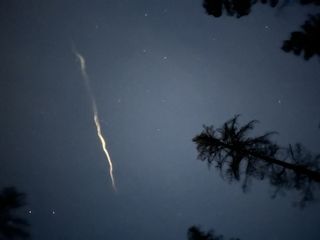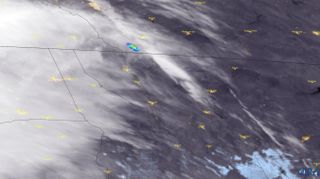15.11.2024
The American Meteor Society received 170 different witness reports about the fireball.
Another fireball lit up the skies this week, this time over the U.S. Midwest and parts of Canada — but unlike the last one, this one came from outer space.
The meteor burned up on the morning of Nov. 13, around 6:31 a.m. Mountain Standard Time (8:31 a.m. EST or 1331 GMT). The resulting fireball appeared to travel southeast and was visible from Alberta and Saskatchewan provinces in Canada and throughout Montana, Idaho and parts of Washington, Wyoming and North Dakota. Numerous doorbell cameras, dash cameras and cell phones captured the fiery spectacle, showing a green streak brightening for a few seconds as it streamed across the early morning sky.
Another fireball was caught on camera earlier in the week on Saturday (Nov. 9), but this one came from a very different source: a falling Starlink satellite that was burning up upon reentry into Earth's atmosphere.

A video of a meteor on Nov. 13, 2024 captured by Matthew Craig and submitted to the American Meteor Society. (Image credit: AMS/Matthew Craig
Based on the videos and eyewitness reports submitted to the American Meteor Society (AMS), this appears to have been a brilliant fireball.
"I've seen (and photographed) several fireballs before, but this was among the most spectacular I've seen," wrote Dave R. of Alberta, Canada. "There was a greenish streak and then a very bright flash. The streak continued but shrunk in brightness. Then there was a secondary smaller and dimmer flash along the same meteor trail. This all occurred within 2 seconds or so."
"All of a sudden I could see the road and my surroundings as if it was early/mid morning," wrote Kaitlynn D. in Corvallis, Montana.
"This was the brightest and longest meteor I have seen this close up," Emily G. of Clancy, Montana wrote in a report to AMS.

A picture of a streak left by a fireball on Nov. 13, 2024 taken by "U Y" of Whitefish, Montana and submitted to the American Meteor Society.
The fireball was even seen from space.
Two of the GOES weather satellites operated by the National Oceanic and Atmospheric Administration's captured the moment the meteor burned up in Earth's atmosphere. One, the GOES-18 spacecraft, saw the meteor with an instrument designed to detect lightning strikes.

Another NOAA satellite, GOES-16, saw the flash using its own lightning sensor. The sensor is designed to detect bright flashes of light, meaning particularly bright meteors will sometimes appear in its data and imagery.
